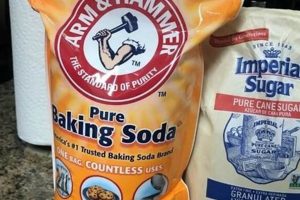The process of applying a protective or decorative layer to a metallic surface using non-industrial tools and readily available materials within a domestic setting represents a growing trend in both hobbyist and practical applications. Examples include applying patinas to brass hardware for an antique aesthetic, powder coating small metal parts in a home oven, or using chemical solutions to achieve a blackened steel look on furniture components.
This approach offers several advantages, including cost savings compared to professional services, complete control over the final appearance, and the satisfaction derived from personal craftsmanship. Historically, the application of coatings to metal objects has been a skilled trade, but the availability of user-friendly products and online resources has broadened accessibility, making it feasible for individuals to achieve professional-looking results in their own workshops. The environmental impact can be reduced by carefully selecting environmentally friendly products and recycling waste materials.
Further discussion will cover surface preparation techniques, various coating options suitable for home application, and best practices for achieving durable and aesthetically pleasing results on metal projects.
Tips for Achieving a Quality Metal Coating in a Home Environment
Effective execution relies on meticulous preparation, careful material selection, and adherence to safety protocols.
Tip 1: Surface Preparation is Paramount: Thoroughly clean the metal substrate, removing any rust, oil, or existing coatings. Media blasting, wire brushing, or chemical etching are viable methods depending on the metal type and level of corrosion.
Tip 2: Invest in Appropriate Safety Gear: Utilize appropriate personal protective equipment (PPE), including respirators, gloves, and eye protection, particularly when working with chemical solutions or power tools.
Tip 3: Choose the Right Coating for the Application: Consider the intended use of the metal object when selecting a coating. Factors to weigh include durability, weather resistance, and desired aesthetic.
Tip 4: Application Technique Matters: Whether using spray paint, powder coating, or chemical patinas, practice proper application techniques. Even coats, appropriate drying times, and adherence to manufacturer instructions are critical.
Tip 5: Control the Environment: Applying coatings in a well-ventilated area, free from dust and debris, will improve the finish quality. Temperature and humidity can also affect coating adhesion and drying times.
Tip 6: Consider the Curing Process: Some coatings require a curing process, such as baking in an oven, to achieve maximum hardness and durability. Follow the manufacturer’s recommendations meticulously.
Tip 7: Test a Small Area First: Before applying a coating to the entire object, test it on a small, inconspicuous area to ensure compatibility and desired results.
Consistent adherence to these guidelines maximizes the chances of achieving a durable and visually appealing coating on metal projects.
The final section will summarize the key considerations and offer concluding remarks on the accessibility and practicality of achieving professional-looking finishes through diligent work.
1. Surface Preparation
Surface preparation represents a foundational stage within any undertaking. Its influence dictates the adhesion, durability, and overall quality of the applied finish. Inadequate preparation invariably leads to premature coating failure, manifesting as peeling, blistering, or corrosion. Consider a rusty steel chair intended for outdoor use. If the rust is not thoroughly removed via methods such as wire brushing or chemical etching, any applied paint or coating will merely adhere to the unstable rust layer. Subsequently, the rust will continue to corrode, detaching the coating and exposing the underlying metal to further degradation. The practical implications are clear: neglecting the initial surface preparation renders the entire effort futile.
Methods employed to achieve optimal surface preparation vary depending on the metal type and the existing condition. Aluminum, for instance, benefits from degreasing and etching to remove oils and create a textured surface for better adhesion. Steel, on the other hand, often requires more aggressive techniques such as abrasive blasting to remove rust and mill scale. Chemical treatments like phosphating can also enhance corrosion resistance and improve paint adhesion. A real-world example: Before applying a powder coat to refurbished motorcycle parts, professionals always suggest removing existing coatings, grease, and corrosion using media blasting, followed by a chemical pre-treatment to create a receptive surface for the powder.
The linkage between surface preparation and the final result is direct and undeniable. Optimal results are contingent upon dedicated effort in the initial stages. The time invested in thorough surface preparation translates directly into enhanced longevity, and improved aesthetic appearance. Ultimately, a seemingly minor oversight in surface preparation can negate the benefits of even the most advanced coating systems, highlighting the crucial role it plays in ensuring successful outcomes.
2. Coating Selection
Appropriate coating selection is paramount to achieving desired performance characteristics and aesthetics when executing metal finishing at home. The chosen coating must be compatible with the base metal and designed for the intended environment to ensure longevity and prevent premature failure.
- Understanding Metal Compatibility
Different metals react differently to various coatings. Applying an incompatible coating can lead to galvanic corrosion, where one metal corrodes preferentially due to electrochemical interactions. For instance, using certain primers designed for steel directly on aluminum can accelerate corrosion of the aluminum substrate. Careful research into metal-coating compatibility charts and manufacturer recommendations is essential.
- Environmental Considerations
The environment in which the finished metal object will reside dictates the necessary performance characteristics of the coating. Items exposed to the elements, such as outdoor furniture, require coatings with UV resistance and corrosion protection. Interior items, such as decorative hardware, may prioritize aesthetic qualities over extreme durability. Epoxy coatings are known for excellent adhesion and chemical resistance, but typically lack UV stability, making them unsuitable for outdoor applications. Conversely, acrylic lacquers offer good UV resistance but less protection against abrasion and chemicals.
- Application Method and Equipment
Home application of coating
s often necessitates different material properties compared to industrial application. Brush-on coatings may require self-leveling properties to minimize brush strokes, while spray coatings demand suitable viscosity and atomization characteristics for use with readily available spray guns. Powder coating, while offering excellent durability, requires specialized equipment, including an electrostatic spray gun and an oven capable of maintaining consistent temperatures. The chosen coating must align with the available application methods and equipment. - Health and Safety Implications
Certain coatings contain volatile organic compounds (VOCs) that pose health risks if proper ventilation and respiratory protection are not employed. Water-based coatings generally have lower VOC content and are considered safer for home use, although their performance characteristics may differ from solvent-based counterparts. Epoxy resins can cause skin sensitization in some individuals, necessitating the use of gloves during application. The health and safety implications of each coating type must be thoroughly understood and mitigated through appropriate safety measures.
Careful consideration of metal compatibility, environmental factors, application methods, and safety implications ensures that the chosen coating delivers the desired aesthetic and performance characteristics while mitigating potential risks associated with do-it-yourself metal finishing. Informed coating selection translates directly into the longevity and visual appeal of the finished product.
3. Application Technique
The proficiency of the application technique directly governs the aesthetic quality, durability, and overall success of any domestic metal finishing endeavor. Even the highest-quality coatings will yield unsatisfactory results if applied incorrectly, highlighting the critical importance of mastering the appropriate methods.
- Surface Coverage and Uniformity
Achieving consistent surface coverage is paramount. Inconsistent application can lead to variations in color, texture, and protective properties. For spray painting, this necessitates maintaining a consistent distance and speed, overlapping each pass by approximately 50%. Brush application requires careful attention to brush strokes, ensuring they are uniform and blended effectively. Variations result in visible imperfections and uneven protection against corrosion. For example, streaks in a clear coat on a polished aluminum surface dramatically diminish the visual appeal.
- Environmental Control
The surrounding environment exerts considerable influence during application. Dust, humidity, and temperature fluctuations can compromise the finish. Dust particles can become embedded in the coating, creating a textured, undesirable surface. High humidity can interfere with drying times and promote blushing or clouding of the finish, particularly with certain lacquer-based products. Temperature extremes can affect viscosity and flow, leading to runs or orange peel texture. An example is applying spray paint in a garage without adequate ventilation, leading to dust contamination and slow drying, resulting in a compromised final product.
- Layering and Curing
Most coating systems require multiple layers to achieve optimal thickness and protection. Adhering to recommended drying times between coats is crucial for proper adhesion and preventing solvent entrapment. Improper curing, such as insufficient baking time for powder coatings, results in a soft, easily damaged finish. Multiple thin coats are generally preferred over single thick coats to minimize runs and ensure even distribution. An illustrative example includes applying multiple thin coats of epoxy primer to a steel gate, followed by a durable topcoat, allowing each layer to fully cure before proceeding, to maximize corrosion resistance.
- Equipment Calibration and Maintenance
Using calibrated and well-maintained equipment is essential for achieving consistent and predictable results. Spray guns require proper nozzle selection, pressure settings, and regular cleaning to prevent clogs and ensure uniform atomization. Brushes should be clean and appropriate for the type of coating being applied. Failure to maintain equipment leads to inconsistent application, wasted materials, and compromised finishes. For example, a clogged spray gun nozzle can result in splattering and uneven coverage, requiring extensive rework to correct.
The nuances of application technique are integral to the success of any metal finishing. By addressing surface coverage, environmental factors, layering procedures, and equipment maintenance, the enthusiast can significantly improve the quality and longevity of finished metal projects, achieving results comparable to professional applications.
4. Safety Measures
The inherent risks associated with materials and processes involved in domestic metal finishing necessitate strict adherence to safety protocols. Mitigation of these risks is paramount to prevent personal injury, property damage, and long-term health consequences. The absence of professional oversight in a non-industrial setting amplifies the importance of individual responsibility in safety management.
- Ventilation and Respiratory Protection
Many coatings, solvents, and cleaning agents release volatile organic compounds (VOCs) and other hazardous fumes. Inadequate ventilation can lead to respiratory irritation, dizziness, nausea, and long-term health problems. Respiratory protection, such as a properly fitted respirator with appropriate cartridges, is essential when working with these materials. For instance, spray painting with solvent-based paints indoors without ventilation poses a significant inhalation hazard.
- Personal Protective Equipment (PPE)
Direct contact with chemicals, abrasive materials, and hot surfaces presents a range of potential injuries. Gloves, eye protection, and protective clothing are crucial for minimizing exposure. Chemical-resistant gloves prevent skin irritation and absorption of harmful substances. Safety glasses or face shields protect against flying debris and chemical splashes. An example: Grinding or sanding metal generates sparks and fine particles; appropriate eye protection prevents corneal abrasions.
- Fire Safety and Material Handling
Many solvents, coatings, and cleaning agents are flammable. Proper storage and handling are essential to prevent fires and explosions. Flammable materials should be stored in tightly sealed containers away from heat sources and open flames. A readily accessible fire extinguisher designed for chemical fires is a necessity. For example, improperly disposing of solvent-soaked rags can lead to spontaneous combustion, necessitating careful handling and disposal in a designated container.
- Safe Disposal Practices
Improper disposal of waste materials, such as used solvents, coatings, and abrasive materials, can contaminate the environment and pose health risks. Local regulations often dictate specific disposal procedures. Recycling programs for used solvents and paints may be available. For example, pouring used paint thinner down a drain can contaminate water sources, emphasizing the need for proper disposal through hazardous waste colle
ction programs.
The proactive integration of safety measures is not merely an ancillary consideration but a fundamental component of the process. The diligent application of these protocols significantly reduces the potential for harm, fostering a secure environment for the successful and responsible execution of at-home metal finishing projects.
5. Curing Process
The curing process constitutes a critical and often decisive stage within any domestic metal finishing project. It is the chemical or physical process that hardens and stabilizes the applied coating, transforming it from a liquid or powder state into a durable, protective film. Inadequate or improper curing invariably compromises the integrity of the finish, negating the effort invested in surface preparation and application. The relationship between curing and the longevity of a at-home metal finish is a direct cause-and-effect scenario. For example, if a powder-coated metal chair is not baked at the correct temperature for the appropriate duration, the coating will remain soft, easily scratched, and prone to chipping, rendering it unsuitable for outdoor use. This example demonstrates the practical importance of understanding and meticulously adhering to the specified curing parameters.
The specific curing requirements vary substantially depending on the type of coating applied. Air-drying paints and lacquers cure through solvent evaporation, a process influenced by ambient temperature, humidity, and air circulation. Two-part epoxy coatings cure through a chemical reaction between resin and hardener, requiring precise mixing ratios and controlled temperature. Powder coatings necessitate baking at elevated temperatures to melt and fuse the powder particles into a continuous film. Each method demands adherence to precise manufacturer guidelines. Consider applying a two-part epoxy to a metal surface at home: if the resin and hardener are not mixed in the correct proportions, the epoxy may either remain tacky indefinitely or cure too rapidly, leading to cracking and poor adhesion. The practical significance lies in understanding the specific requirements for each coating and tailoring the curing process accordingly.
In summary, the curing process is an inseparable component of successful metal finishing. Its proper execution dictates the durability, appearance, and protective qualities of the final product. Ignoring the intricacies of curing leads to premature coating failure and a waste of resources. While challenges exist in replicating industrial curing conditions in a home environment, meticulous adherence to manufacturer instructions and careful control of environmental factors will maximize the chances of achieving professional-quality results.
Frequently Asked Questions
This section addresses common inquiries regarding the application of metal finishes in a non-industrial setting. The information provided is intended to clarify crucial aspects of the process and assist in achieving satisfactory results.
Question 1: What constitutes adequate surface preparation prior to applying a finish?
Adequate surface preparation involves the complete removal of rust, scale, oil, grease, existing coatings, and any other contaminants that could impede coating adhesion. The specific method employed will vary depending on the substrate material and the nature of the contaminants. Options include mechanical abrasion (e.g., sanding, wire brushing, media blasting), chemical etching, and degreasing.
Question 2: Are specialized tools necessary to achieve a professional-looking finish?
While certain tools, such as spray guns or powder coating equipment, can enhance the quality and efficiency of the application, they are not always essential. Brush application, when executed carefully, can yield acceptable results. The key is to select appropriate tools for the chosen coating and the scale of the project, and to ensure proper maintenance and calibration of the equipment.
Question 3: How can environmental factors affect the outcome of a metal finishing project?
Environmental factors, such as temperature, humidity, and dust, can significantly influence the adhesion, drying time, and overall quality of the finish. Coatings should be applied within the temperature and humidity ranges specified by the manufacturer. Dust-free environments are desirable to prevent contamination of the finish. Adequate ventilation is crucial when working with coatings containing volatile organic compounds (VOCs).
Question 4: What safety precautions should be observed during this process?
The use of personal protective equipment (PPE), including respirators, gloves, and eye protection, is mandatory when working with coatings, solvents, and abrasive materials. Adequate ventilation is essential to prevent inhalation of hazardous fumes. Flammable materials should be stored and handled with extreme care. Proper disposal of waste materials, such as used solvents and coatings, is necessary to prevent environmental contamination.
Question 5: How important is the curing process, and what factors influence it?
The curing process is critical for hardening and stabilizing the applied coating. Factors influencing the curing process include temperature, humidity, air circulation, and the presence of UV light (for certain coatings). Adhering to the manufacturer’s recommended curing times and temperatures is essential for achieving optimal results. Insufficient curing can result in a soft, easily damaged finish.
Question 6: What are common indicators of a poorly executed metal finish?
Common indicators of a poorly executed finish include peeling, blistering, cracking, chipping, runs, sagging, orange peel texture, and inconsistent color or gloss. These defects can result from inadequate surface preparation, improper application techniques, unsuitable environmental conditions, or incorrect curing procedures.
In summary, achieving a successful outcome relies on diligent planning, meticulous execution, and strict adherence to safety protocols. The application of metal coatings in a home setting presents unique challenges, but with careful attention to detail, professional-quality results are attainable.
The next section will provide a comparative overview of several different finish types.
DIY Metal Finish at Home
This exploration has detailed the multifaceted nature of “diy metal finish at home,” underscoring the critical importance of surface preparation, appropriate coating selection, proper application techniques, adherence to safety measures, and meticulous execution of the curing process. Each element contributes directly to the durability, aesthetic quality, and longevity of the final product. Successfully navigating these aspects requires diligent planning, careful execution, and a comprehensive understanding of the materials and processes involved. Without this dedication, unsatisfactory and potentially hazardous outcomes are probable.
The application of coatings represents more than mere surface decoration; it serves as a crucial protective measure, preserving metal objects and extending their useful life. While industrial methods offer unmatched precision and efficiency, the principles and practices outlined demonstrate that satisfactory and lasting results can be achieved within a home environment. The careful consideration of these elements enables the creation of lasting, visually appealing metalwork.







